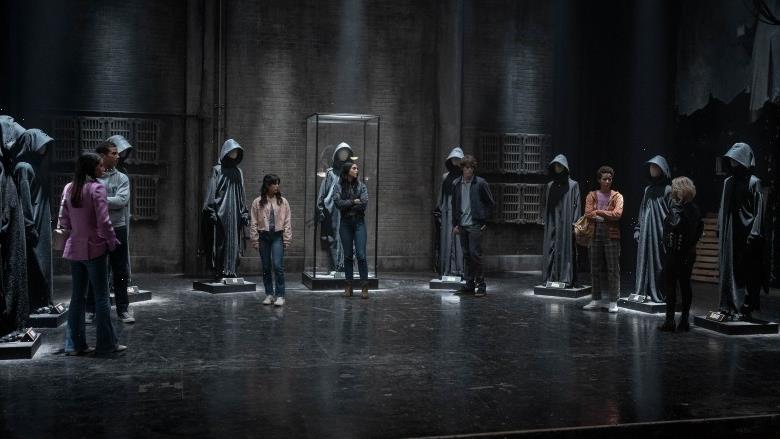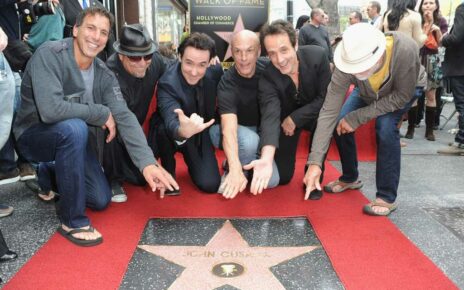The “Scream” films have been self-referential ever since Drew Barrymore first picked up the phone to riff on scary movies with her killer, but “Scream VI” is the most meta entry yet, thanks to a climactic set piece in a Ghostface museum. Built in an old theater by a killer from an earlier “Scream,” the museum is filled with artifacts from the first five films in the series, from weapons and clothes to beer cups from the party scene in the original movie. The location is not only a source of terror for prospective victims and of pride for its creator but a gift to fans of the franchise, who can luxuriate in the attention to detail taken with every exhibit.
Read More: The Scariest Thing About Directing a ‘Scream’ Film? ‘Not F**king Up’ Wes Craven’s Horror Legacy
The museum was a labor of love for production designer Michèle Laliberté and costume designer Avery Plewes, who took a deep dive into the previous “Scream” movies to decide what would populate the set. “We went through the films and made a list of all the murders and all the victims,” Laliberté told IndieWire, explaining that the one rule was that the items in the museum had to be from “real” murders — in other words, not from the “Stab” series of movies-within-the-movies that began in “Scream 2” and reached a hilarious peak in the nesting doll opening of “Scream 4.” “The only ‘Stab’ objects were related to ‘Scream 3,’ which was about the making of a ‘Stab’ movie,” Laliberté said.
Once the filmmakers compiled a list of over a hundred artifacts they thought belonged in the museum, the real work began — complicated by the fact that nothing was saved from the previous films. “There was nothing left, there were no props available,” said Laliberté. “Not even the graphics files from the posters and book covers, so we had to recreate everything.”
This created particular challenges for Plewes and costumer Myriam Hanahem, whose office “looked like when the FBI is trying to catch a serial killer,” according to Plewes. Some of the most seemingly simple items became the most difficult to execute, such as the iconic robe worn by Stu (Matthew Lillard) in the original “Scream.” “From what I understand, Matthew Lillard got that robe from a crew member who had it and just threw it on,” Plewes told IndieWire. “It was not a planned costume, so there was no record of what brand it was or anything. I had to trace the pattern on my computer screen and recreate it from scratch.”


“Scream VI”
Philippe Bossé
Props and costumes from the earlier movies weren’t the only things unavailable to the makers of “Scream VI”; Laliberté also didn’t have access to images of the victims in the original films. “For multiple legal reasons, we didn’t have rights to photos of those actors,” Laliberté said. She felt that some of the weapons and props would make more sense and have greater meaning if they were displayed alongside the faces of the victims associated with them, so she hired an illustrator to create drawings of the various actors as though they were created by the museum’s curator. The result was a solution to a practical obstacle that yielded artistic dividends. “It started as a problem or a challenge, but I think it’s more interesting than if we just had photos of the victims in the displays. In the end, it’s much more emotional.”
Read More: The ‘Scream’ Producers Have a Plan to Keep Ghostface Going Forever
One of the pleasures of Laliberté and Plewes’ meticulousness is the way that “Scream VI” rewards repeat viewings, as the frame is filled with delightful details that are easy to miss — Laliberté’s team even recreated the Doritos bag that Kenny (W. Earl Brown) was snacking on when he got killed “Scream.” “Even though most people aren’t seeing it, we made sure it was a period Doritos bag,” Laliberté said. “There were layers upon layers of fun stuff with graphics, props, and costumes.” Plewes felt the same way, finding that the precision required for the museum clothes was part of the fun. “I’m really crazy about fabric, so I was looking at images up close and personal,” she said. “There’s a polo shirt from ‘Scream 4’ that just looks like a normal polo shirt from afar, but it’s actually an Abercrombie slug knit. To normal people, a polo shirt is a polo shirt, but I felt no, it has to be accurate down to the logo.”
Both Laliberté and Plewes knew that the fans would scrutinize every piece of minutiae. “At first, I was terrified because ‘Scream’ fans are so beautifully intense,” Plewes said. “I thought, ‘What have I gotten myself into?’ Then I got really excited.” Laliberté discovered the benefit of designing for a franchise with such an avid fan base when she used the internet to research the earlier films. “If you have a question and you go online, you get a list of analyses and theories and find all these things other people saw that you might have missed,” she said. “It was a great crash course.”
Plewes feels that if the museum set piece inspires viewers to go back and revisit the earlier “Scream” films, she’s done her job. “To me, the museum is really about, ‘How much of a fan are you?’” she said, noting how many details, like the bulletproof vest on the Ghostface costume from “Scream 3,” are only visible for a second. “If you can identify everything, you’re really an upper-echelon ‘Scream’ fan. But I think the museum is also a roadmap to the other movies that will hopefully make people say, ‘I don’t know what that is — I need to rewatch that ‘Scream.’” Plewes herself gained a newfound appreciation for the earlier movies and “Scream” 1-4 director Wes Craven. “Wes Craven is one of the greats,” she said. “He made a classic film that really paved the way for a lot of the cinema that we see today, so the fact that so many of my friends who are die-hard ‘Scream’ fans have seen this movie and like it… it’s such a relief!”
Source: Read Full Article



